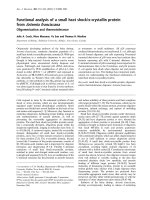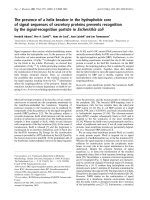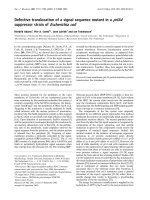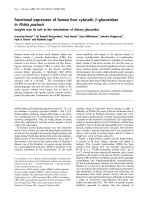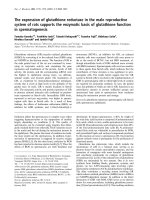Báo cáo Y học: Heterologous expression of a Rauvolfia cDNA encoding strictosidine glucosidase, a biosynthetic key to over 2000 monoterpenoid indole alkaloids pot
Bạn đang xem bản rút gọn của tài liệu. Xem và tải ngay bản đầy đủ của tài liệu tại đây (538.87 KB, 10 trang )
Heterologous expression of a
Rauvolfia
cDNA encoding strictosidine
glucosidase, a biosynthetic key to over 2000 monoterpenoid indole
alkaloids
Irina Gerasimenko, Yuri Sheludko, Xueyan Ma and Joachim Sto¨ ckigt
Lehrstuhl fu
¨
r Pharmazeutische Biologie, Institut fu
¨
r Pharmazie, Johannes Gutenberg-Universita
¨
t Mainz, Germany
Strictosidine glucosidase (SG) is an enzyme that catalyses the
second step in the biosynthesis of various classes of mono-
terpenoid indole alkaloids. Based on the comparison of
cDNA sequences of SG from Catharanthus roseus and
raucaffricine glucosidase (RG) from Rauvolfia serpentina,
primers for RT-PCR were designed and the cDNA encoding
SG was cloned from R. serpentina cell suspension cultures.
The active enzyme was expressed in Escherichia coli and
purified to homogeneity. Analysis of its deduced amino-acid
sequence assigned the SG from R. serpentina to family 1 of
glycosyl hydrolases. In contrast to the SG from C. roseus,
the enzyme from R. serpentina ispredictedtolackan
uncleavable N-terminal signal sequence, which is believed to
direct proteins to the endoplasmic reticulum. The tempera-
ture and pH optimum, enzyme kinetic parameters and
substrate specificity of the heterologously expressed SG were
studied and compared to those of the C. roseus enzyme,
revealing some differences between the two glucosidases.
In vitro deglucosylation of strictosidine by R. serpentina SG
proceeds by the same mechanism as has been shown for the
C. roseus enzyme preparation. The reaction gives rise to the
end product cathenamine and involves 4,21-dehydrocory-
nantheine aldehyde as an intermediate. The enzymatic
hydrolysis of dolichantoside (Nb-methylstrictosidine) leads
to several products. One of them was identified as a new
compound, 3-isocorreantine A. From the data it can be
concluded that the divergence of the biosynthetic pathways
leading to different classes of indole alkaloids formed in
R. serpentina and C. roseus cell suspension cultures occurs at
a later stage than strictosidine deglucosylation.
Keywords: strictosidine b-
D
-glucosidase; heterologous
expression; Rauvolfia serpentina; ajmaline; indole alkaloid
biosynthesis.
Elucidation of the biosynthesis of natural plant products
has been a matter of investigation for over half a century.
Although there have been major efforts in the field, only
very few biosynthetic pathways have been delineated in
detail at the enzymatic level. Knowing the enzymes involved
is, however, a prerequisite for understanding the biosyn-
thetic mechanisms. The next steps are to search for the
participating genes and to clarify the regulation of product
synthesis, with the aim of influencing the biosynthesis on a
rational basis. The best known pathways comprise those of
the flavonoid biosynthesis [1,2], the isoquinoline alkaloid
formation [3,4] and the biosynthesis of indole alkaloids [5,6].
The key intermediate in the biosynthesis of all mono-
terpenoid indole alkaloids is the glucoalkaloid strictosidine
[7–10]. It is formed by condensation of tryptamine, the
decarboxylation product of tryptophan, and the monoter-
pene secologanin catalysed by the enzyme strictosidine
synthase (SS) [11]. The biosynthetic pathways leading to
different classes of indole alkaloids branch off somewhere
downstream of strictosidine. The first point where this
divergence may take place is the deglucosylation of strict-
osidine catalysed by strictosidine glucosidase (SG). The
unstable aglycone formed in this reaction is further conver-
ted through unknown intermediates to different indole
alkaloids exhibiting structurally most diverse carbon skel-
etons (Fig. 1). About 2000 of these secondary metabolites
are known to occur in higher plants. Many of them are
important because of various pharmacological and thera-
peutic applications such as the cytostatic vincaleucoblastine
and vincristine used in cancer chemotherapy, the toxin
strychnine, the vasodilative yohimbine, the neuroleptic
reserpine, the antihypertensive ajmalicine and the anti-
arrhythmic ajmaline.
The complex chemical structure of ajmaline, an alkaloid
from the Indian medicinal plant Rauvolfia serpentina Benth.
ex Kurz, consists of a hexacyclic carbon skeleton bearing
nine chiral carbon centres. About 10 enzymes participate in
its formation [5]. The cloning and heterologous expression
has already been achieved for a number of enzymes of this
pathway, such as SS [12,13], polyneuridine aldehyde esterase
(PNAE) [14], the cytochrome P450 reductase (M. Ruppert
&J.Sto
¨
ckigt, unpublished results) and the raucaffricine
glucosidase (RG) [15,16]. It is one of our future aims to
heterologously express the entire biosynthetic pathway
Correspondence to J. Sto
¨
ckigt, Lehrstuhl fu
¨
r Pharmazeutische
Biologie, Institut fu
¨
r Pharmazie, Johannes Gutenberg-Universita
¨
t
Mainz, Staudinger Weg 5, 55099 Mainz, Germany.
Fax: + 49 6131 3923752, Tel.: + 49 6131 3925751,
E-mail:
Abbreviations: CAS, ceric ammonium sulfate reagent; IPTG, isopropyl
thio-b-
D
-galactoside; NBA, 3-nitrobenzylalcohol; RG, raucaffricine
glucosidase; SG, strictosidine glucosidase; SS, strictosidine synthase;
PNAE, polyneuridine aldehyde esterase.
Enzyme: strictosidine b-
D
-glucosidase (EC 3.2.1.105).
Note: the cDNA sequence of SG from Rauvolfia serpentina was
submitted to the GenBank under accession number AJ302044.
(Received 18 November 2001, revised 6 March 2002,
accepted 12 March 2002)
Eur. J. Biochem. 269, 2204–2213 (2002) Ó FEBS 2002 doi:10.1046/j.1432-1033.2002.02878.x
leading from strictosidine to ajmaline. In the present article,
we report on cloning and heterologous expression in
Escherichia coli of the cDNA from R.serpentina cell
suspension cultures coding for SG [17]. An analogous
enzyme was characterized from cell suspension cultures of
Catharanthus roseus [18,19] and recently it has been cloned
from the same source and heterologously expressed in yeast
[20]. In our study, we compare the primary structure,
general properties, enzyme kinetics and substrate specificity
of both glucosidases. The unstable intermediates and the
end products formed during in vitro deglucosylation of
strictosidine and its Nb-methylated derivative (dolichanto-
side) are also investigated.
MATERIALS AND METHODS
Plant material
Cell suspensions were cultivated in 1-L conical flasks
containing 300 mL liquid Linsmaier and Skoog (LS)
medium [21] at 100 r.p.m. in diffuse light (600 lux).
Cloning of SG cDNA
Total RNA from 6-day-old R. serpentina cell suspension
cultures was isolated using peqGOLD RNAPure solution
(PEQLAB, Erlangen, Germany) according to the manu-
facturer’s manual. OligoT primer (T
15
-NNN) and RLM
reverse transcriptase (Promega, Mannheim, Germany) were
used for first strand cDNA synthesis. PCR was carried out
in Genius thermocycler (Techne, Burkhardtsdorf,
Germany) with Taq DNA polymerase from Gibco (Karls-
ruhe, Germany) under the following conditions: 94 °Cfor
5 min, followed by 35 cycles of 94 °Cfor1min,60°Cfor
1.5 min, 72 °Cfor2min,thenheldat72°C for 5 min. The
1311-bp fragment was amplified with primers F5 (5¢-CAAT
TTGTACAAGGAAGATATC-3¢, forward) and R2 (5¢-TT
AGTATTTTTGCTTCTTGAC-3¢, reverse). The 3¢-and5¢
RACE PCR was carried out with gene specific primers
GSP3 (5¢-GGAGGGTGGCAGCATGTCGTTCCTTGG
GG-3¢,forward),GSP5a(5¢-GTGGCTTCTTGAGTCAT
AGAATCGTGGATGAC-3¢, reverse) and GSP5b (5¢-GT
GCATACAACGAAGGCAATCGAGGTCC-3¢, reverse)
using Marathon
TM
cDNA Amplification Kit and Advant-
ageÒ cDNA polymerase from Clontech (Heidelberg,
Germany) according to the manufacturer’s manual. The
full-length cDNA was amplified by PCR using AdvantageÒ
cDNA polymerase from Clontech under following condi-
tions: 94 °C for 1 min, followed by 35 cycles of 94 °Cfor
0.5 min, 60 °Cfor1.5min,72°C for 3 min, then held at
72 °C for 5 min. The primer pairs NcoI(5¢-GGTG
GTCCAT GGACAATACTCAAGC-3¢,forward)–PstI
(5¢-CTGCA GTTAGGTTTTTTGCCTCTTGACTAAC-
3¢,reverse)andNdeI(5¢-CACATATGGACAATACTCA
AGCTGA GCC-3¢,forward)–SapI(5¢-TGCTCTTCC
GCAGGTTTTTTGCCTCTTGAC-3¢, reverse) were used
to introduce respective restriction sites at the ends of the
ORF. After ligation into pGEMÒ-T Easy Vector (Prome-
ga), both strands of the obtained fragment were sequenced
by primer walking using the dideoxy chain termination
method [22].
Sequence analysis
The deduced amino-acid sequence was scanned for the
occurrence of conserved patterns using the
PROSITE
[23]
database. For prediction of transmembrane helices the
servers
HMMTOP
[24],
TMHMM
[25] and
SOSUI
(Tokyo
University of Agriculture & Technology) were used. The
subcellular localization was predicted by
PSORT
server [26].
Expression and purification of SG
The restriction enzymes were purchased from New England
Biolabs (Schwalbach/Taunus, Germany); the T4 DNA
ligase was from Promega. The full-length SG cDNA was
inserted in the NcoIandPstI sites of the pSE280 vector
(Invitrogen, Karlsruhe, Germany) and expressed in E. coli
strain TOP10 (Invitrogen) growing in liquid Luria–Bertani
medium supplemented with 50 mgÆL
)1
ampicillin at 37 °C.
A control bacterial culture contained the vector pSE280
without an insert. To obtain a crude enzyme preparation,
100 mL of an overnight grown E. coli culture was centri-
fuged (4500 g, 10 min), the cells taken up in 1 mL sterile H
2
O
and crashed with ultrasonic. The supernatant after centrif-
ugation for 30 min at 35 000 g wasusedtotestSGactivity.
The pure heterologously expressed SG was obtained using
IMPACT
TM
-CN system (New England Biolabs) according
to the manufacturer’s manual. The full-length SG cDNA
was ligated in the NdeIandSapI sites of the pTYB1 vector
and transformed into E. coli strain ER2566. Transformants
were selected on Luria–Bertani medium supplemented with
50 mgÆL
)1
ampicillin. For purification of SG 50 mL of fresh
grown bacterial culture were inoculated into 2.5 L of the
above nutrition medium and incubated at 28 °C. When
D
600
¼ 0.5, IPTG (final concentration 0.5 m
M
)wasadded
to induce expression. Cells were harvested after 13 h of
cultivation at 28 °C by centrifugation for 15 min at 5000 g
and taken up in 50 mL of cell break buffer (20 m
M
Tris/HCl,
pH 8.0; 1 m
M
EDTA; 0.5
M
NaCl; 0.1% Triton X-100).
After cracking the cells in a French press, the crude extract
was centrifuged (15 000 g, 30 min) and loaded onto gravity
flow column (diameter 3 cm) packed with chitin beads
(20 mL) and pre-equilibrated with 200 mL of column buffer
(20 m
M
Tris/HCl, pH 8.0; 1 m
M
EDTA; 0.5
M
NaCl). After
washing with 150 mL of cell break buffer followed by
150 mL of column buffer, the column was flashed with
50 mL of cleavage buffer (20 m
M
Tris/HCl, pH 8.0; 1 m
M
EDTA; 0.5
M
NaCl; 50 m
M
dithiothreitol). The flow was
stopped and the column kept for 23 h at 4 °C for cleavage of
Fig. 1. The key role of strictosidine in the
biosynthesis of different classes of monoterpe-
noid indole alkaloids.
Ó FEBS 2002 Cloning of strictosidine glucosidase from Rauvolfia (Eur. J. Biochem. 269) 2205
intein tag. SG was eluted with column buffer (fraction size
0.5 mL). Fractions 3–22 with protein concentration higher
than 15 lg
ÆmL
)1
were combined and dialyzed against
2 · 1 L of Tris/EDTA buffer (20 m
M
Tris/HCl, pH 8.0;
1m
M
EDTA) yielding a solution with protein concentration
of 13 lgÆmL
)1
and specific SG activity of 350 pkatÆlg
)1
protein. The purity of SG was analyzed on Coomassie and
silver stained SDS/PAGE.
Protein determination and enzyme assays
Protein concentrations were measured by the method of
Bradford [27] using bovine serum albumin (Merck, Darms-
tadt, Germany) as standard. Strictosidine glucosidase
activity was calculated on the basis of strictosidine decrease
measured by HPLC. A typical assay contained appropriate
enzyme activities between 1 and 8 pkat and 20 nmol of
strictosidine in 5 lL MeOH in total volume of 50 lL0.1
M
citrate/phosphate buffer (pH 5.0) and was incubated for 15
or 30 min at 30 °C. The reaction was terminated by
addition of 100 lL MeOH. After centrifugation (11 000 g,
5 min) the supernatant was analyzed by HPLC on CC 250/
4 Nucleosil 100–5 C18 column (Macherey-Nagel, Du
¨
ren,
Germany) using the following solvent system: acetonitrile/
39 m
M
NaH
2
PO
4
(pH 2.5), gradient 15 : 85 fi 25 : 75
within 1 min, fi 40 : 60 within 6.5 min, fi 40 : 60
for 2.5 min, fi 85 : 15 within 0.5 min, fi 85 : 15 for
4.5 min, fi 15 : 85 within 0.5 min, fi 15 : 85 for 4.5 min;
1.2 mLÆmin
)1
flow rate, detection at 250 nm. For substrate
specificity studies an alternative strictosidine glucosidase
activity assay was used based on quantitative determination
of released glucose. The reaction mixture (total volume
100 lL, 0.1
M
citrate/phosphate buffer, pH 5.0) containing
putative substrates (400 nmol in 20 lLMeOH)and0.13 lg
strictosidine glucosidase (45.5 pkat with strictosidine) was
incubated at 30 °C overnight (16 h). The reaction was
terminated with 200 lLMeOH,and100 lL of the resulting
mixture were added to 1 mL of the Glucose Trinder
Reagent (Sigma, Deisenhofen, Germany). The D
505
was
measured after 20 min. Control incubations were carried
out without the enzyme. To check the stability of SG during
the over night reaction, the sample containing 0.13 lgof
enzyme without substrate was incubated in the same
conditions, 20 nmol of strictosidine were added after 16 h,
the reaction mixture incubated for further 1 h and SG
activity analyzed by HPLC.
Properties of the enzyme
Enzyme kinetic parameters (K
m
and V
max
) were determined
in presence of 13 ng (with strictosidine), 26 ng (with 5a-
carboxystrictosidine) or 65 ng (with 19,20-dihydro- and Nb-
methylstrictosidine) of SG in 0.1
M
citrate/phosphate buffer
(pH 5.0), 15 min incubation at 30 °C. The substrate con-
centrations tested were: 10 l
M
)500 l
M
of strictosidine,
50 l
M
)250 l
M
of 5a-carboxystrictosidine, 100 l
M
)250 l
M
of 19,20-dihydrostrictosidine, and 25 l
M
)250 l
M
of
Nb-methylstrictosidine. The pH optimum was determined
by incubation of 20 nmol of strictosidine with 26 ng of SG
for 30 min at 30 °C in different buffers: 0.1
M
citrate/
phosphate (pH 3.8–7.0), 0.1
M
KP
i
(pH 5.8–8.0), and 0.1
M
Tris/HCl (pH 7.0–9.0). The temperature optimum was
determined by incubation of 12.5 nmol of strictosidine with
13 ng of SG in 0.1
M
citrate/phosphate buffer (pH 5.0) for
30 min at different temperatures (13–65 °C). Inhibition by
0.25 m
M
cathenamine, 0.25 m
M
ajmaline, 1 m
M
serpentine
and 1 m
M
CuSO
4
was studied by incubation of 12.5 nmol
of strictosidine with 26 ng of SG in 0.1
M
citrate/phosphate
buffer (pH 5.0) for 30 min at 30 °C.
Size-exclusion chromatography was conducted with
Superdex 75 HR 10/30 column (Pharmacia) (CV 30 mL).
The proteins were eluted with 20 m
M
Tris/HCl buffer,
pH 8.0, containing 2 m
M
Na
2
EDTA, 10% glycerol and
10 m
M
2-mercaptoethanol at a flow rate of 24 mLÆh
)1
collecting 0.1 mL fractions for SG activity test.
General experimental procedures
For thin layer chromatography (TLC), 0.2-mm or 0.5-mm
silica gel 60 F
254
plates, 20 · 20 cm (Merck, Darmstadt,
Germany) were used with the solvent systems SS1/petro-
leum ether/acetone/diethylamine (7 : 2 : 1) or SS2/CHCl
3
/
MeOH (8 : 2). Substances were detected by measuring the
A
254
and colours after spraying with ceric ammonium sulfate
reagent (CAS). EI-MS measurements were carried out with
a quadrupole instrument (Finnigan MAT 44S) at 70 eV.
HR-EI-, HR-FAB-, and FD-MS spectra were recorded on
JEOL JMS-700 mass spectrometer.
1
H-NMR spectra were
measured using AMX 400 and DRX 600 instruments
(Bruker, Karlsruhe, Germany) with CDCl
3
and pyridine-
d
5
as solvents. The COSY, NOESY, HSQC and HMBC
experiments were performed on the DRX 600 instrument.
Preparation of substrates
Strictosidine was prepared according to the published
procedure [28] or isolated from Rauvolfia serpen-
tina · Rhazya stricta somatic hybrid cell subcultures
RxR17K as reported [29]. Dolichantoside was prepared
from strictosidine by methylation using NaBH
3
CN and
HCHO [30].
Synthesis and identification of deglucosylation
products
Strictosidine (1 mg) dissolved in 100 lLMeOHwas
incubated in H
2
O(totalvol.1mL)with450lg crude
enzyme preparation from transgenic E. coli for 1 h at
30 °C. For control assays the enzyme preparation was
heated in a boiling water bath for 20 min. After centrifu-
gation (11 000 g, 5 min) the pellet (formed after incubation
with the active enzyme only) was freeze-dried. The main
component was identified as cathenamine (8) by EI-MS and
1
H-NMR as well as by HR-FAB-MS: m/z 351.1720
([M + H]
+
,calc.forC
21
H
23
O
3
N
2
, 351.1709), 503.2037
([M + NBA]
+
,calc.forC
28
H
29
O
6
N
3
, 503.2056).
Identification of intermediate under reducing
conditions
(a) Strictosidine (225 nmol) was incubated in 0.1
M
citrate/
phosphate buffer (pH 5.0) (total volume 1.5 mL) with
132 lg crude transgenic E. coli protein in presence of
450 nmol NaBH
3
CN for 15 min at 30 °C. The reaction
mixture was extracted with ethyl acetate. The organic phase
was evaporated and the residue analyzed by 2D-TLC with
2206 I. Gerasimenko et al. (Eur. J. Biochem. 269) Ó FEBS 2002
solvent system SS1. The product located at Rf 0.51 was
identified as tetrahydroalstonine (12) by comparison of its
EI-MS data with those of an authentic sample.
(b) Strictosidine (0.45 lmol) was incubated in 0.1
M
citrate/phosphate buffer (pH 5.0) (total vol. 1.5 mL) with
132 lg crude transgenic E. coli protein in presence of
900 lmol NaBH
3
CN for 15 min at 30 °C. The reaction
mixture was extracted with ethyl acetate. After evaporation
of the organic phase the remaining residue was analyzed by
2D-TLC with solvent system SS1. Two products located at
Rf 0.34 and 0.44 were identified as sitsirikine (10) and
isositsirikine (11) by their EI-MS data. Experiments with
4000-fold excess of KBH
4
were carried out analogously in
1
M
KP
i
buffer (pH 7.5–8.0).
Deglucosylation of dolichantoside
Dolichantoside (30 mg, 55 lmol) was incubated with 39 lg
SG in 30 mL 0.1
M
citrate/phosphate buffer (pH 5.0)
overnight (16–18 h) at 30 °C. The reaction mixture was
extracted with an equal volume of EtOAc, pH of the water
phase adjusted to 8.0 with 25% ammonia and extraction
with equal volume of EtOAc repeated. The organic phases
were evaporated and chromatographed using solvent sys-
tem SS2. The product at R
f
0.64 showing blue fluorescence
at 366 nm after spraying with CAS was eluted yielding 1 mg
of (9)(2.6lmol, 4.7%). 3-isocorreantine A (9): EI-MS m/z
(rel.int.%)382(7,M
+
), 381 (10), 367 (7), 213 (10), 199 (8),
185 (100), 171 (15), 156 (18), 144 (17). HR-EI-MS: m/z
382.1884 (M
+
,calc.forC
22
H
26
O
4
N
2
, 382.1893), 367.1681
(M
+
-CH
3
,calc.forC
21
H
23
O
4
N
2
, 367.1658).
1
HNMR
(600 MHz, pyridine-d
5
): d 1.50 (1H, m, H-14b), 1.57 (3H, d,
J ¼ 6.5, H
3
-18), 1.73 (1H, m, H-14a), 2.39 (3H, s, Nb-CH
3
),
2.56 (1H, m, H-20), 2.60 (1H, m, H-5b), 2.68 (1H, m, H-6b),
3.02 (1H, dd, 14.2, 2.7, H-6a), 3.52 (1H, d, J ¼ 11.5, H-5a),
3.67 (3H, s, CO
2
CH
3
), 3.82 (1H, m, H-15), 3.87 (1H, dd,
13.7, 6.4, H-3), 4.36 (1H, dq, J ¼ 9.3, 6.5, H-19), 6.48 (1H,
s, H-21), 7.26 (1H, dd, J ¼ 7.7, 7.7, H-10), 7.30 (1H, dd,
J ¼ 7.7, 7.7, H-11), 7.61 (1H, d, J ¼ 7.7, H-9), 7.82 (1H, s,
H-17), 7.91 (1H, d, J ¼ 7.7, H-12).
13
C NMR (determined
from HSQC and HMBC spectra, 600 MHz, pyridine-d
5
): d
18.3 (q, C-18), 24.9 (t, C-14), 29.1(d, C-15), 32.4 (t, C-6),
41.8 (q, Nb-CH
3
), 46.0 (d, C-20), 50.4 (q, CO
2
CH
3
), 52.9
(t, C-5), 60.8 (d, C-3), 76.7 (d, C-19), 78.2 (d, C-21), 108.7
(s, C-7), 111.6 (d, C-12), 112.1 (s, C-16), 118.3 (d, C-9), 119.9
(d, C-10), 122.0 (d, C-11), 128.0 (s, C-8), 137.6 (s, C-13),
138.3 (s, C-2), 154.7 (d, C-17), 168.1 (s, CO
2
CH
3
). Import-
ant NOE correlations: H-3–H-14a; H-15–H-19; H-21–H-
12, H
3
-18, H-19, H-20.
RESULTS AND DISCUSSION
Cloning of cDNA encoding strictosidine glucosidase
Primers for PCR were designed on the basis of comparison
of cDNA sequences of strictosidine glucosidase (SG) from
C. roseus [20] and raucaffricine glucosidase (RG) from
R. serpentina [16], two enzymes expected to have the highest
homology to the SG from R. serpentina.RT-PCRexperi-
ments yielded a 1311-bp long DNA fragment with a high
homology of 79.9% to C. roseus SG. After successful
amplification of cDNA ends containing start and stop
codons, the full-length cDNA was generated by PCR with
primers for 3¢ and 5¢ ends including the necessary restriction
sites. As the 5¢ RACE PCR products contained an in-frame
stop codon 12 bp upstream of the start codon, the obtained
ORF of 1599 bp was full-length (Fig. 2). The encoded
protein of 532 amino acids has a calculated molecular mass
of 60.881 kDa and an isoelectric point of 6.01 differing from
the C. roseus SG (Table 1). The deduced amino-acid
sequence shows 70% homology to SG from C. roseus
followed by RG from R. serpentina (56%) and other plant
b-glucosidases. The presence of a family 1 glycosyl hydrol-
ase N-terminal signature (position 47–61) allows assignment
of the SG from R. serpentina to this enzyme family [31]. It is
noteworthy that in the second signature of glycosyl
hydrolases family 1 (position 412–419), which contains the
putative nucleophile catalytic glutamic acid [32,33], in
position 417 asparagine is changed to serine. This position
is also modified in SG from C. roseus, where glutamic acid
is followed by cysteine (Fig. 3). Region-directed mutagen-
esis of b-glucosidase from Agrobacterium faecalis indicated
that this asparagine residue does not play a critical role in
catalysis [33]. In the SGs this residue is not conserved,
supporting the above mentioned results. In contrast, the
next glycine proved to be essential for enzyme activity
probably due to its small size necessary for the right
conformation of the active site [33]. This residue is indeed
conserved in both SGs and RG. The second catalytic
glutamic acid acting as proton donor is suggested to be
located upstream of the nucleophile in the highly conserved
motif NEP (position 206–208) [34,35]. The sequence
DxxRxxY near the C-terminus (position 435–441) is also
conserved in family 1 of glycosyl hydrolases, although it
was shown that only aspartic acid plays an important, but
not critical, role in catalysis [33]. Analysis of the R.serpen-
tina SG deduced amino-acid sequence revealed no regions
predicted to form transmembrane helices. In contrast to the
SG from C. roseus,theR. serpentina enzyme lacks an
uncleavable N-terminal signal sequence that would direct
the protein to the endoplasmic reticulum (ER) and form a
transmembrane segment, as predicted using
PSORT
software
[26]. The length and peak value of the central hydrophobic
region and the net charge of the N-terminal basically
charged region were considered to predict the presence of
signal sequence and the absence of consensus pattern
around the cleavage sites suggests that the putative signal
sequence of C. roseus SG is uncleavable [26]. The SG from
C. roseus was indicated to be localized in the ER by sucrose
gradient analysis and in vivo enzyme activity staining studies
[20], although earlier ultracentrifugation experiments
showed that the C. roseus SG occurs in at least two forms,
one soluble and one membrane-associated [36].
To prove whether the cDNA cloned from R. serpentina
indeed encoded the SG, it was expressed in E. coli. Crude
extracts of the bacteria transformed with pSE280 vector
containing SG cDNA showed high strictosidine glucosidase
activity (2.4 pkatÆlg
)1
total protein), whereas for control
cultures bearing the same vector without insert no SG activity
could be detected. These results allow us to conclude that the
cloned cDNA indeed encodes SG from R. serpentina.
Properties of heterologously expressed SG
To achieve simple and efficient purification of the enzyme,
SGwasexpressedinfusionwiththeinteintag[37]and
Ó FEBS 2002 Cloning of strictosidine glucosidase from Rauvolfia (Eur. J. Biochem. 269) 2207
bound on a chitin column. After self-cleavage of the intein
sequence in presence of thiol, native SG without any
additional amino acids was eluted from the column. The
enzyme became enriched 250-fold and showed a single band
on silver stained SDS/PAGE (Fig. 4). This solution con-
taining pure SG was used for further determination of
enzyme properties.
Optimum catalytic activity was expressed at a tempera-
ture of 50 °C. The temperature optimum for SG from
C. roseus cell suspensions was reported to be 30 °C[18],
although the enriched Catharanthus enzyme was highly
stable up to 50 °C [19]. Whether the high temperature
optimum of R. serpentina SG may be attributed specifically
to Rauvolfia cells is uncertain. But another enzyme isolated
from the same cell suspension culture, arbutin synthase, also
displayed an optimum catalytic activity at 50 °C [38,39]. SG
showed a pH optimum at 5.2 with activity of 50% of the
maximum at pH 4.2 and slowly decreasing up to pH 8.0.
These results are in contrast with those reported for SG
from C. roseus by different authors (Table 1). They resem-
ble, however, values known for nonspecific plant b-
D
-
glucosidases [40]. Similar to the SG from C. roseus,the
R. serpentina enzyme was inhibited by 1 m
M
Cu
2+
and
1m
M
serpentine, although at a significant lower degree
(Table 1), indicating a close relationship of both enzymes.
The K
m
value for strictosidine was 0.12 m
M
, which corres-
Fig. 2. cDNA Sequence and deduced amino
acid sequence of SG from R. serpentina. Motifs
conserved in members of glycosyl hydrolases
family 1 are shaded, the putative catalytic
glutamate residues are marked. A, proton
donor. B, nucleophile.
2208 I. Gerasimenko et al. (Eur. J. Biochem. 269) Ó FEBS 2002
ponds well to the data of two SG enzymes characterized
from C. roseus cell cultures [18], although the K
m
value
determined for C. roseus SG recently [19] is much lower
(Table 1). The stable end product of in vitro strictosidine
deglucosylation, cathenamine, as well as the final product of
the indole alkaloid biosynthetic pathway in R. serpentima,
ajmaline, did not inhibit the enzymatic reaction at 0.25 m
M
concentration.
Size-exclusion chromatography on Superdex-75 column
revealed that the purified heterologously expressed SG from
R. serpentina has a molecular mass > 450 kDa, as it has
been demonstrated earlier for the Catharanthus enzyme
(Table 1).
Substrate specificity
For the first time the pure SG was incubated with a great
variety of b-
D
-glucosides, 34 in total, most of them being
natural products of different classes. Five of these com-
pounds were converted at a rate of 0.8–90% compared to
strictosidine (Table 2). Except of ipecoside which derives
from enzymatic condensation of secologanin and dopamine
[41] and is deglucosylated at a low rate of 0.8%, all other
accepted substrates possess the basic skeleton of strictosi-
dine. The a(S) configuration at C3 is essential for SG from
R. serpentina as well as for glucosidase from C. roseus
[18,19]. Whereas vincoside, the 3b(R) epimer of strictosidine,
Table 1. Comparison of properties of strictosidine glucosidases from R. serpentina and C. roseus . ND, not determined.
SG from C. roseus
cell suspension cultures [18]
SG from C. roseus
cell suspension cultures [19]
SG from C. roseus
expressed in yeast [20]
SG from R. serpentina
expressed in E. coli
Enrichment factor 120 60.2 ND 250
K
m
0.2 m
M
(I) £ 20 l
M
ND 0.12 m
M
0.1 m
M
(II)
V
max
0.23 n
M
Æmin
)1
(I) 180–230 pkatÆmg
)1
ND 347 pkatÆlg
)1
0.12 n
M
Æmin
)1
(II)
pH optimum 6.0–6.4 6.0–8.5 ND 5.0–5.2
Temperature optimum 30 °CND ND50°C
Inhibition by ND ND
1m
M
Cu
2+
50% 8.8%
1m
M
Serpentine 50% 25.2%
M
r
230 kDa (I) >1500 kDa 63.043 kDa (calculated); 60.881 kDa (calculated);
>450 kDa (II) >660 kDa >450 kDa
pI (calculated) ND ND 5.73 6.01
Fig. 3. Alignment of deduced amino acid
sequences of three glucosidases involved in
indole alkaloid biosynthesis. SG_Rs: SG from
R.serpentina,SG_Cr:SGfromC. roseus,
RG_Rs: RG from R. serpentina. Identical
amino acids are shaded. Motifs conserved in
members of glycosyl hydrolases family 1 are
highlighted black, the putative catalytic glu-
tamate residues are marked. A, proton donor.
B, nucleophile.
Ó FEBS 2002 Cloning of strictosidine glucosidase from Rauvolfia (Eur. J. Biochem. 269) 2209
is not accepted, the 5a-carboxystrictosidine with 3a(S)
configuration has a relative conversion rate of 90%.
Changing the structure of strictosidine by acetylation of
the b nitrogen leads to more significant decrease of
conversion than methylation of the b nitrogen or hydro-
genation of the isolated 18,19-double bond (Table 2). Indole
alkaloids possessing a sarpagine or ajmaline ring system
were not accepted (Table 2), as well as 21 nonindole
glucosides tested (secologanin, loganin, p-nitrophenylglu-
coside, arbutin, vanillin-glucoside, vanillylalcohol-phenyl-
glucoside, picein, salicin, amygdalin, avetiin, 6-bromo-
2-naphthyl-b-
D
-glucoside, cinnamic acid glucoside, con-
iferin, esculin, fluorescein-glucoside, isatinoxim-glucoside,
prunasin, rhapontin, rutin, sinigrin and zeatin-glucoside).
Thus the SG from R. serpentina has a high degree of
substrate specificity, as it has been also observed for the
C. roseus SG [18,19].
Products of enzymatic deglucosylation of strictosidine
With sufficient expression of SG in E. coli, pure R. serpen-
tina enzyme activities became available for the first time to
investigate the mechanism of strictosidine conversion
in more detail (Fig. 5). Similar experiments have been
previously carried out with rather crude enzyme extracts
from C. roseus cell suspensions [42]. To gain more detailed
insight into the mechanism of strictosidine conversion, we
carried out a series of experiments. Incubation of strictosi-
dine with heterologously expressed SG led to the formation
of cathenamine (8) exhibiting identical EI-MS and
1
H
NMR data (not shown) with those previously reported [43].
As it cannot be excluded that unstable intermediates formed
after strictosidine deglucosylation may change their struc-
ture during EI-MS measurement, milder ionization tech-
niques were applied. But the FD-MS and HR-FAB-MS
spectra confirmed that the main deglucosylation product
represents cathenamine (8). We therefore concluded that the
in vitro deglucosylation of strictosidine by SG from
R. serpentina results in the same product as the reaction
catalysed by SG from C. roseus [43].
In order to intercept putative precursors of cathenamine
(8) formed immediately after hydrolysis of strictosidine (1)
(Fig. 5), the enzymatic reaction was carried out in presence
of reducing agents (NaBH
3
CN and KBH
4
)whichare
expected to reduce aldehyde groups in (5) and thus
prevent it from further conversion. When a twofold excess
of NaBH
3
CN was added, only tetrahydroalstonine (12)
was detected. This result supports the identification of (8)
as the end product of the cell-free strictosidine degluco-
sylation, as the reduction of (8) leads to tetrahydroalsto-
nine. When the concentration of NaBH
3
CN was increased
to a 2000-fold excess, the two products sitsirikine (10)and
isositsirikine (11) were identified, which demonstrates that
4,21-dehydrocorynantheine aldehyde (7) is involved in the
indole alkaloid biosynthesis in R. serpentina as well as it
has been shown earlier for C. roseus [42].
Further experiments to identify other intermediates
applying hydroxylamine and thiols were unsuccessful, as
well as attempts to impede the bond rotation necessary for
the ring D closure by conducting the enzymatic reaction at
low temperature in presence of reducing agents (data not
shown).
Deglucosylation of dolichantoside
To retard the intramolecular condensation of the C-21
aldehyde and Nb amino groups leading to ring closure, we
modified the structure of strictosidine. Nb-Methylstrictosi-
dine (dolichantoside) (2) was found to be the only substrate
with substituted b-nitrogen that was converted by the
enzyme at sufficient rate (Table 2). Its incubation with SG
resulted in the formation of several products. EI-MS
screening revealed that the most unpolar of them had a
molecular mass of 382, corresponding to the putative
Nb-methyldialdehyde (6). HR-EI-MS measurement
confirmed the elemental composition C
22
H
26
O
4
N
2
.But
the
1
H-NMR spectrum showed no signals which would
correspond to the expected aldehyde protons, as well as to
the vinyl side chain. Absence of a signal from Na-H
suggested that one of the aldehyde groups of (6)hasreacted
with the Na amino group. In addition, chemical shifts of Nb
methyl protons (d 2.39), H-3 (d 3.87) and protons at C-5 (d
2.60 and 3.52) indicated a tertiary b nitrogen. Presence of a
methyl group at d 1.57 correlated in the
1
H-
1
HCOSY
spectrum to H19 at d 4.36 suggested the closure of the ring
E, which is confirmed by the shift of H-17 (d 7.82). H-21
appears as a singlet at d 6.48 correlated on NOESY
Fig. 4. Silver stained SDS/PAGE of heterologously expressed SG.
Lane 1, crude protein extract from transgenic E. coli;lane2,molecular
mass marker; lane 3, eluted active strictosidine glucosidase.
2210 I. Gerasimenko et al. (Eur. J. Biochem. 269) Ó FEBS 2002
spectrum to one of the aromatic protons (H-12 at d 7.91)
indicating that C-21 bears an hydroxyl function and is
adjacent to Na. The structure elucidation of the new
alkaloid was completed by HSQC, HMBC and NOESY
measurements, which enabled the determination of the
chemical shifts of carbons and the relative stereochemistry.
Fig. 5. Enzymatic conversion of strictosidine
and its Nb-methyl derivative by heterologously
expressed strictosidine glucosidase from
R. serpentina cell suspension cultures.
Table 2. Substrate specificity of pure heterolo-
gously expressed SG form R. serpentina. ND,
not determined.
a
Determined by HPLC.
Ó FEBS 2002 Cloning of strictosidine glucosidase from Rauvolfia (Eur. J. Biochem. 269) 2211
The novel compound is the 3-isomer of correantine A,
which has been isolated from Psychotria correae [44].
As reported recently, the enzymatic deglucosylation of
dolichantoside by a crude enzyme preparation from
Strychnos mellodora resulted in the formation of a
quaternary alkaloid, Nb-methyl-21-hydroxy-mayumbine,
as a major product, in which the condensation of C-21
aldehyde and Nb amino groups occurred [45]. The pattern
of conversion products was the same after incubation of
dolichantoside with SG from C. roseus (as crude enzyme
preparation) and a less specific glucosidase from sweet
almonds [45]. The 3-isocorreantine A identified in this
study was, however, not detected in these experiments,
although when treated with an unspecific b-glucosidase,
3-isodolichantoside gave correantine A and its 21-epimer
[44]. Our detection of 3-isocorreantine suggests that the
dialdehyde (6) is released from the enzyme and converts
immediately to (9). Bearing in mind that the reduction
of 18,19-double bond in strictosidine can influence its
binding the SG (which is demonstrated by a higher K
m
value, Table 2), the bond rotation necessary for the
reaction between C-21 and Na is not likely to occur in
the enzyme–substrate complex. The described experiments
indicate that the ring D closure is a fast and spontaneous
reaction.
CONCLUSIONS
It has been suggested that SG may play a role in the
divergence of indole alkaloid biosynthetic pathways [20].
This present study demonstrates that the in vitro conversion
of strictosidine by SGs from two different plants, C. roseus
and R. serpentina, occurs by the same mechanism. It results
in the same end product cathenamine and involves the same
intermediate 4,21-dehydrocorynantheine aldehyde. The
formation of the 3-isocorreantine A after hydrolysis of
dolichantoside is an indication that the deglucosylation
product is released from the enzyme before the ring D is
closed. From these data, it can be concluded that the
divergence of the biosynthetic pathways leading to different
classes of indole alkaloids formed in R. serpentina and
C. roseus cell suspension cultures occurs at a later stage than
strictosidine deglucosylation, i.e. after formation of 4,21-
dehydrogeissoschizine, which has been shown to be con-
verted into ajmalicine type alkaloids or geissoschizine by the
enzyme preparations from C. roseus [46]. The knowledge of
the cDNA sequence and the possibility of obtaining high
amounts of pure active SG may help to identify and
characterize further enzyme(s) of ajmaline biosynthesis
converting the reactive intermediates formed after strictosi-
dine hydrolysis.
ACKNOWLEDGEMENTS
Financial support from Deutsche Forschungsgemeinschaft (Bonn, Bad
Godesberg, Germany) and by the Fonds der Chemischen Industrie
(Frankfurt/Main, Germany) is highly appreciated. X. M. is very
grateful to BASF Company (Ludwigshafen, Germany) for providing a
scholarship. We also thank Mr H. Kolshorn (Institute of Organic
Chemistry, Mainz, Germany) for NMR measurements and helpful
discussion, Dr J. Gross (Institute of Organic Chemistry, Heidelberg,
Germany) for FD-, HR-FAB- and HR-EI-MS spectra, and to
Dr D. Strand (Mainz, Germany) for linguistic advice.
REFERENCES
1. Winkel-Shirley, B. (2001) Flavonoid biosynthesis. A colorful
model for genetics, biochemistry, cell biology, and biotechnology.
Plant Physiol. 126, 485–493.
2. Forkmann, G. & Martens, S. (2001) Metabolic engineering and
applications of flavonoids. Curr. Opin. Biotechnol. 12, 155–160.
3. Zenk, M.H. (1995) Chasing the enzymes of alkaloid biosynthesis.
In Organic Reactivity: Physical and Biological Aspects (Golding,
B.T., Griffin, R.J. & Maskill, H., eds), pp. 89–109. The Royal
Society of Chemistry, Newcastle upon Tune, UK.
4. Grothe, T., Lenz, R. & Kutchan, T.M. (2001) Molecular char-
acterization of the salutaridinol 7-O-acetyltransferase involved in
morphine biosynthesis in opium poppy Papaver somniferum.
J. Biol. Chem. 276, 30717–30723.
5. Sto
¨
ckigt, J. (1995) Biosynthesis in Rauwolfia serpentina –modern
aspects of an old medicinal plant. In The Alkaloids. Chemistry and
Pharmacology (Cordell, G.A., ed.), pp. 115–172. Academic Press,
New York.
6. Sto
¨
ckigt, J. (1998) Alkaloid metabolism in plant cell culture. In
Natural Product Analysis (Schreier, P., Herderich, M., Humpf,
H.M. & Schwab, W., eds), pp. 313–325. Vieweg Braunschweig,
Wiesbaden.
7. Sto
¨
ckigt, J. & Zenk, M.H. (1977) Strictosidine (isovincoside): the
key intermediate in the biosynthesis of monoterpenoid indole
alkaloids. J. Chem. Soc. Chem. Commun. 646–648.
8. Sto
¨
ckigt, J. & Zenk, M.H. (1977) Isovincoside (strictosidine), the
key intermediate in the enzymatic formation of indole alkaloids.
FEBS Lett. 79, 233–237.
9. Rueffer, M., Nagakura, N. & Zenk, M.H. (1978) Strictosidine, the
common precursor for monoterpenoid indole alkaloids with 3a
and 3b configuration. Tetrahedron Lett. 1593–1596.
10. Nagakura,N.,Rueffer,M.&Zenk,M.H.(1979)TheBiosynthesis
of monoterpenoid indole alkaloids from strictosidine. J. Chem.
Soc. Perkin Trans. I, 2308–2312.
11. Hampp, N. & Zenk, M.H. (1988) Homogeneous strictosidine
synthase from cell suspension cultures of Rauvolfia serpentina.
Phytochemistry 27, 3811–3815.
12. Kutchan, T.M., Hampp, N., Lottspeich, F., Beyreuther, K. &
Zenk, M.H. (1988) The cDNA clone for strictosidine synthase
from Rauvolfia serpentina. DNA Sequence determination and
expression in Escherichia coli. FEBS Lett. 237, 40–44.
13. Kutchan, T.M. (1989) Expression of enzymatically active cloned
strictosidine synthase from the higher plant Rauvolfia serpentina in
Escherichia coli. FEBS Lett. 257, 127–130.
14. Dogru, E., Warzecha, H., Seibel, F., Haebel, S., Lottspeich, F. &
Sto
¨
ckigt, J. (2000) The gene encoding polyneuridine aldehyde
esterase of monoterpenoid indole alkaloid biosynthesis in plants is
an ortholog of the a/b hydrolase super family. Eur. J. Biochem.
267, 1397–1406.
15. Warzecha, H., Obitz, P. & Sto
¨
ckigt, J. (1999) Purification, partial
amino acid sequence and structure of the product of raucaffricine-
O-b-
D
-glucosidase from plant cell cultures of Rauvolfia serpentina.
Phytochemistry 50, 1099–1109.
16. Warzecha, H., Gerasimenko, I., Kutchan, T.M. & Stockigt, J.
(2000) Molecular cloning and functional bacterial expression of a
plant glucosidase specifically involved in alkaloid biosynthesis.
Phytochemistry 54, 657–666.
17. Gerasimenko, I., Sheludko, Y., Ma, X. & Sto
¨
ckigt, J. (2001)
Properties of heterologously expressed strictosidine glucosidase
from Rauvolfia serpentina cell suspension culture. In Traits, Tracks
and Traces, 49
th
Annual Congress of the Society for Medicinal Plant
Research, Abstracts 2.5, Germany.
18. Hemscheidt, T. & Zenk, M.H. (1980) Glucosidases involved in
indole alkaloid biosynthesis of Catharanthus cell cultures. FEBS
Lett. 110, 187–191.
19. Luijendijk, T.J.C., Stevens, L.H. & Verpoorte, R. (1998) Purifi-
cation and characterisation of strictosidine b-
D
-glucosidase from
2212 I. Gerasimenko et al. (Eur. J. Biochem. 269) Ó FEBS 2002
Catharanthus roseus cell suspension cultures. Plant Physiol. Bio-
chem. 36, 419–425.
20. Geerlings, A., Iban
˜
ez, M.M.L., Memeling, J., van der Heiden, R. &
Verpoorte, R. (2000) Molecular cloning and analysis of strictosi-
dine b-
D
-glucosidase, an enzyme in terpenoid indole alkaloid bio-
synthesis in Catharanthus roseus. J. Biol. Chem. 275, 3051–3056.
21. Linsmaier, E.M. & Skoog, F. (1965) Organic growth factor
requirements of tobacco tissue cultures. Physiol. Plant. 18, 100–
127.
22. Sanger, F., Nicklen, S. & Coulson, A.R. (1977) DNA sequencing
with chain-terminating inhibitors. Proc. Natl Acad. Sci. USA 74,
5463–5467.
23. Hofmann, K., Bucher, P., Falquet, L. & Bairoch, A. (1999) The
PROSITE database, its status in 1999. Nucleic Acid Res. 27, 215–
219.
24. Tusnady, G.E. & Simon, I. (1998) Principles governing amino acid
composition of integral membrane proteins: applications to
topology prediction. J. Mol. Biol. 283, 489–506.
25. Sonnhammer, E.L.L., von Heijne, G. & Krogh, A. (1998) A
hidden Markov model for predicting transmembrane helices in
protein sequences. In Proceedings of the of Sixth International
Conference on Intelligent Systems for Molecular Biology (Glasgow,
J., Littlejohn, T., Major, F., Lathrop, R., Sankoff, D. & Sensen,
C., eds), pp. 175–182. Menlo Park, CA: AAAI Press.
26. Nakai, K. & Kanehisa, M. (1992) A knowledge base for predicting
protein localization sites in eukaryotic cells. Genomics 14, 897–911.
27. Bradford, M.M. (1976) A rapid and sensitive method for the
quantification of microgram quantities of protein utilizing the
principle of protein-dye binding. Anal. Biochem. 72, 248–254.
28. Pfitzner, U. & Zenk, M.H. (1982) Immobilisation of strictosidine
synthase from Catharanthus cell cultures and preparative synthesis
of strictosidine. Planta Med. 46, 10–14.
29. Sheludko, Y., Gerasimenko, I. & Platonova, O. (2000) Divergence
of the indole alkaloid pattern in two somatic hybrid plant cell
subcultures of Rauvolfia serpentina · Rhazya stricta. Planta Med.
66, 656–659.
30. Achenbach, H. & Benirschke, M. (1997) Constituents of tropical
medicinal plants. 81. Confirmation of the absolute configuration
of dolichantoside and isodolichantoside by synthesis from
(–)-secologanin. Phytochemistry 44, 1387–1390.
31. Henrissat, B. & Davies, G. (1997) Structural and sequence-based
classification of glycoside hydrolases. Curr. Opin. Struct. Biol. 7,
637–644.
32. Withers, S.G., Warren, R.A.J., Street, I.P., Rupitz, K., Kempton,
J.B. & Aebersold, R. (1990) Unequivocal demonstration of the
involvement of a glutamate residue as a nucleophile in the
mechanism of a ÔretainingÕ glycosidase. J. Am. Chem. Soc. 112,
5887–5889.
33. Trimbur, D.E., Warren, R.A.J. & Withers, S.G. (1992) Region-
directed mutagenesis of residues surrounding the active site
nucleophile in b-glucosidase from Agrobacterium faecalis. J. Biol.
Chem. 267, 10248–10251.
34. Baird, S.D., Hefford, M.A., Johnson, D.A., Sung, W.L., Yaguchi,
M. & Seligi, V.L. (1990) The Glu residue in the conserved Asn-
Glu-Pro sequence in two highly divergent endo-beta-1,4-gluca-
nases is essential for enzymatic activity. Biochem. Biophys. Res.
Commun. 169, 1035–1039.
35. Keresztessy, Z., Kiss, L. & Hughes, M.A. (1994) Investigation of
theactivesiteofthecyanogenicb-
D
-glucosidase (linamarase) from
Manihot esculenta Crantz (cassava). II. Identification of Glu-198
as an active site carboxylate group with acid catalytic function.
Arch. Biochem. Biophys. 315, 323–330.
36. Stevens, L.H., Blom, T.J.M. & Verpoorte, R. (1993) Subcellular
localization of tryptophan decarboxylase, strictosidine synthase
and strictosidine glucosidase in suspension cultured cells of
Catharanthus roseus and Tabernamontana divaricata. Plant Cell
Report 12, 573–576.
37. Chong,S.,Mersha,F.B.,Comb,D.G.,Scott,M.E.,Landry,D.,
Vence, L.M., Perler, F.B., Benner, J., Kuchera, R.B., Hirvonen,
C.A., Pelletier, J.J., Paulus, H. & Xu, M.Q. (1997) Single column
purification of free recombinant proteins using a self-cleavable
affinity tag derived from a protein splicing element. Gene 192, 277–
281.
38. Arend, J., Warzecha, H. & Sto
¨
ckigt, J. (2000) Hydroquinone:
O-glucosyltransferase from cultivated Rauvolfia cells: enrichment
and partial amino acid sequences. Phytochemistry 53, 187–193.
39. Arend,J.,Warzecha,H.,Hefner,T.&Sto
¨
ckigt, J. (2001) Utilizing
genetically engineered Escherichia coli to produce plant specific
glucosides. Biotechn Bioeng. 76, 126–131.
40. Dey, P.M. & Del Campillo, E. (1984) Biochemistry of the multiple
forms of glucosidases in plants. In Advances in Enzymology and
Related Areas of Molecular Biology, 56 (Meister, A., ed.), pp. 141–
249. Willy-Interscience, New York.
41. De-Eknamkul, W., Suttipanta, N. & Kutchan, T.M. (2000) Pur-
ification and characterization of deacetylipecoside synthase from
Alangium lamarckii Thw. Phytochemistry 55, 177–181.
42. Sto
¨
ckigt, J., Rueffer, M., Zenk, M.H. & Hoyer, G.A. (1978)
Indirect identification of 4,21-dehydrocorynantheine aldehyde as
an intermediate in the biosynthesis of ajmalicine and related
alkaloids. Planta Med. 33, 188–192.
43. Sto
¨
ckigt, J. (1979) Enzymatic formation of intermediates in the
biosynthesis of ajmalicine: strictosidine and cathenamine. Phyto-
chemistry 18, 965–971.
44. Achenbach, H., Lottes, M., Waibel, R., Karikas, G.A., Correa,
M.D. & Gupta, M.P. (1995) Alkaloids and other compounds from
Psychotria correae. Phytochemistry 38, 1537–1545.
45. Brandt, V., Tits, M., Penelle, J., Frederich, M. & Angenot, L.
(2001) Main glucosidase conversion products of the gluco-
alkaloids dolichantoside and palicoside. Phytochemistry 57,
653–659.
46. Rueffer, M., Kan-Fan, C., Husson, H.P., Sto
¨
ckigt, J. & Zenk,
M.H. (1979) 4,21-Dehydrogeissoschizine, an intermediate in het-
eroyohimbine alkaloid biosynthesis. J. Chem. Soc. Chem. Com.
1016–1018.
Ó FEBS 2002 Cloning of strictosidine glucosidase from Rauvolfia (Eur. J. Biochem. 269) 2213

